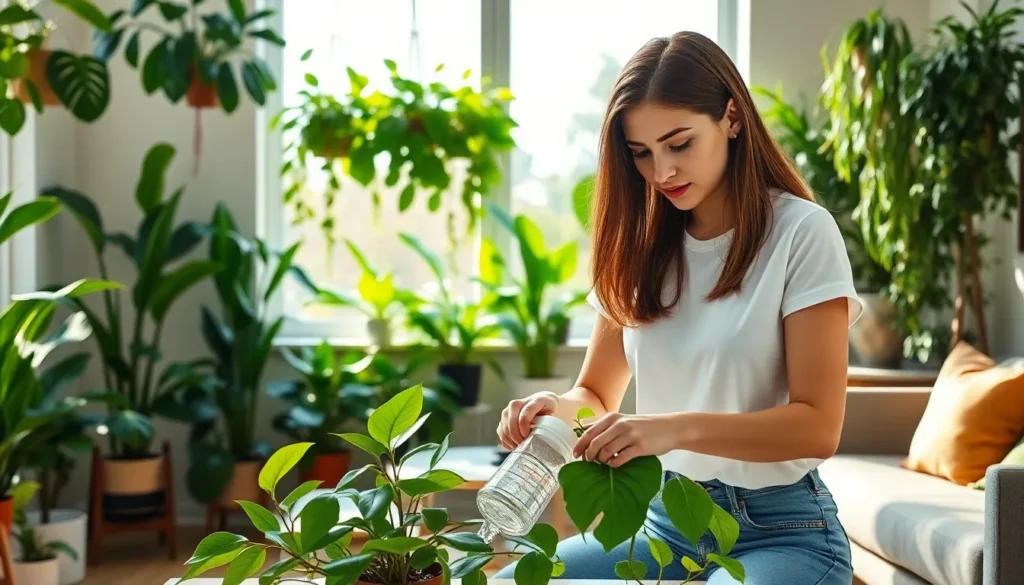Transform your living space into a lush sanctuary that breathes life and style into every corner. The house with plants aesthetic has captured hearts worldwide as we discover the perfect balance between natural beauty and modern design. This trending interior style doesn’t just make our homes look stunning – it creates an atmosphere that promotes wellness and tranquility.
We’ve all scrolled through Instagram feeds filled with enviable plant-filled rooms that seem to glow with vitality. From cascading pothos trailing down floating shelves to statement fiddle leaf figs commanding attention in minimalist corners, plants have become the ultimate design accessory. They’re nature’s artwork that never goes out of style.
Creating this coveted aesthetic isn’t about turning your home into a jungle – it’s about thoughtfully incorporating greenery that complements your lifestyle and space. Whether you’re a seasoned plant parent or just starting your green journey, we’ll show you how to achieve that effortlessly chic plant-filled home that makes every day feel like a retreat.
Create a Green Foundation With Large Statement Plants
Large statement plants anchor your house with plants aesthetic by establishing bold focal points that instantly transform any room. These commanding green specimens set the tone for your entire plant collection while maximizing visual impact.
Choose Floor Plants That Make an Impact
Fiddle leaf figs create dramatic vertical interest with their broad, violin-shaped leaves that can reach ceiling height in bright, indirect light. We recommend placing these Instagram-famous plants near south-facing windows where they’ll develop their signature glossy foliage and commanding presence.
Monstera deliciosas bring tropical sophistication to your plant aesthetic with their iconic split leaves that develop distinctive holes as they mature. These climbing beauties thrive in medium light conditions and can grow up to 10 feet tall indoors, making them perfect conversation starters.
Bird of paradise plants offer exotic elegance with their paddle-shaped leaves that can span 18 inches wide and tower 6 feet high. We love how these dramatic specimens add architectural structure to modern living spaces while requiring minimal maintenance.
Rubber trees provide glossy, dark green foliage that creates stunning contrast against white walls and contemporary furniture. These adaptable plants tolerate various lighting conditions and can grow 6 to 10 feet indoors, making them ideal for corners that need vertical interest.
Position Plants in High-Traffic Areas for Maximum Visual Effect
Living room corners benefit from tall floor plants that soften harsh angles and create natural flow between furniture pieces. We suggest placing your largest specimens like fiddle leaf figs or bird of paradise plants in these prominent spots where guests will notice them immediately.
Entryways make perfect showcases for statement plants that greet visitors with lush greenery the moment they enter your home. Position medium to large plants like monstera deliciosas or snake plants near your front door to establish your plant aesthetic from the very first impression.
Dining room spaces come alive with floor plants positioned near windows or in corners adjacent to your dining table. We recommend choosing plants that won’t obstruct conversation views while still providing that essential green backdrop for memorable meals.
Bedroom areas transform into serene retreats when you place air-purifying floor plants like rubber trees or peace lilies in corners where they can filter the air while you sleep. These strategic placements maximize both aesthetic appeal and wellness benefits throughout your daily routine.
Design Plant-Filled Living Spaces That Feel Natural
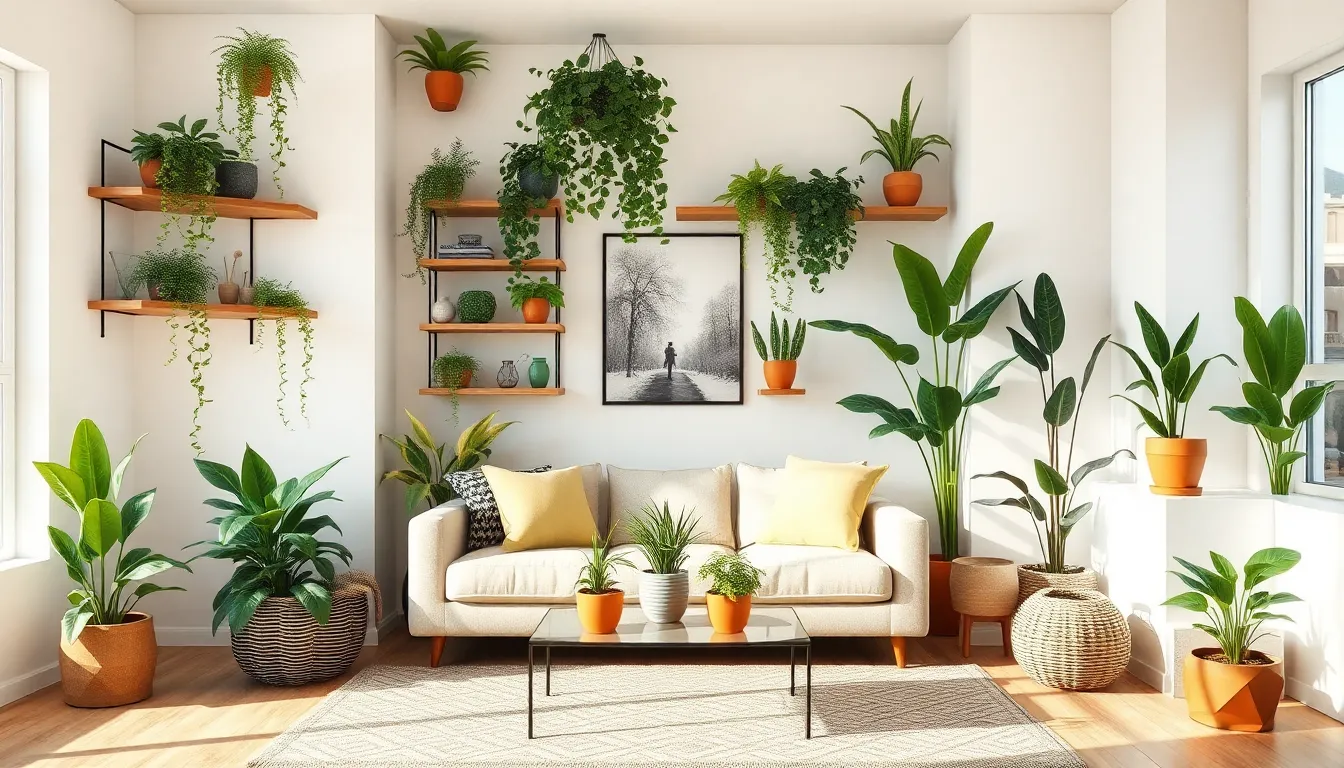
Transforming our living spaces with plants creates the organic flow that makes our homes feel more connected to nature. Building on our statement plants, we can develop a cohesive aesthetic that softens architectural elements while maintaining our interior design style.
Integrate Plants Into Your Existing Furniture Layout
Complement your furniture pieces by positioning plants alongside or atop existing surfaces rather than overwhelming the space. Trailing plants like pothos, heartleaf philodendron, or pepperomia work beautifully on high shelves or ledges, creating natural cascades that soften harsh lines and square furniture edges.
Style plants strategically on desks, side tables, and in corners to provide visual interest where straight architectural lines dominate. Bushier plants excel on lower surfaces like coffee tables or plant stands, helping balance the scale of larger furniture pieces while adding lush texture to awkward transitions between rooms.
Choose containers thoughtfully to unify your plant collection with your existing decor style. Ceramic pots enhance modern interiors, while terracotta vessels complement boho aesthetics, ensuring our plants feel intentionally integrated rather than randomly placed throughout the space.
Use Varying Plant Heights to Create Visual Depth
Mix plant heights deliberately to avoid flat, monotonous arrangements that lack visual impact. Tall plants like fiddle leaf figs or snake plants establish vertical focal points, while medium height specimens fill eye level spaces and low growing plants anchor floor level areas.
Layer different elevations using plant stands, hanging planters, and floor positioned containers to create ever-changing depth and dimension. This strategic height variation breaks up visual monotony and introduces the natural flow that makes boxy rooms feel alive and inviting.
Arrange plants in groupings that include at least three different height levels for maximum visual interest. The interplay between tall, medium, and low plants mimics natural forest canopies, creating the organic layering that transforms flat spaces into environments with genuine botanical depth.
Master the Art of Plant Grouping and Clustering
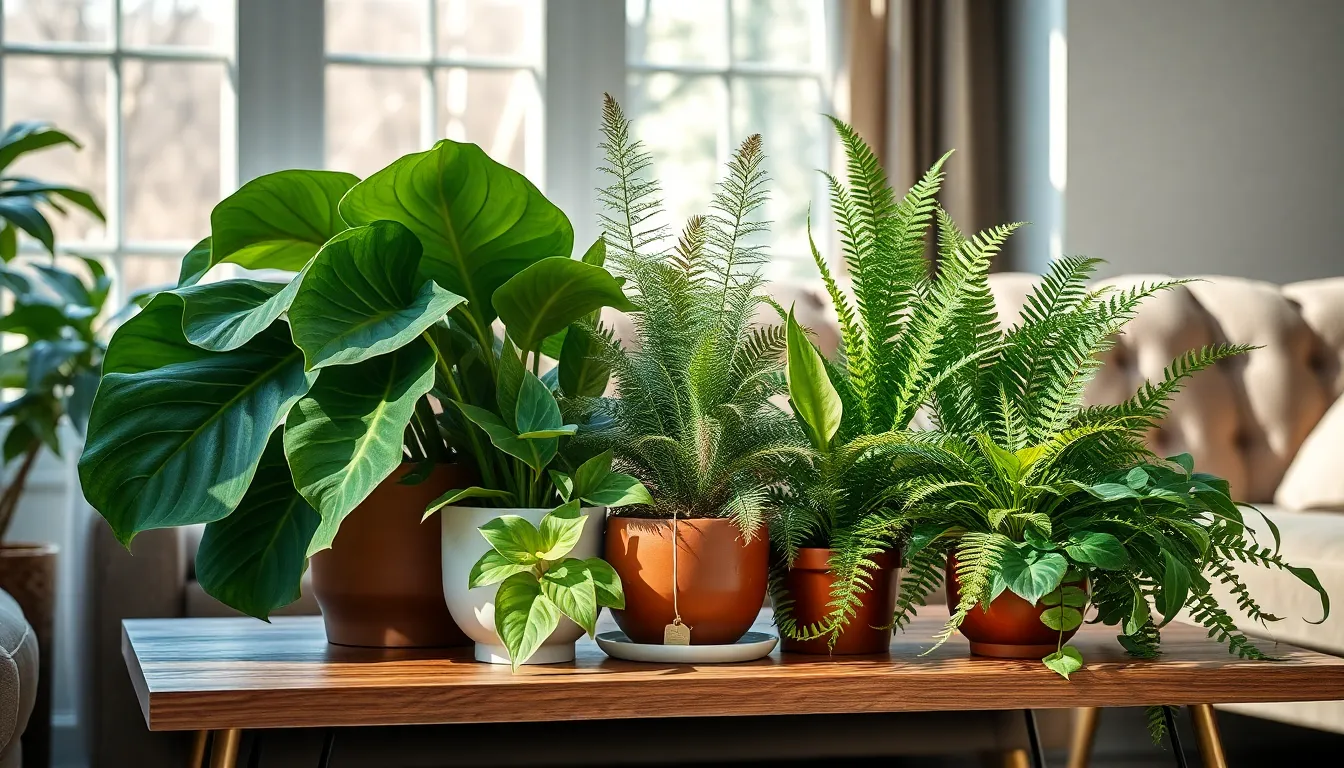
Creating visual harmony with plants starts with strategic clustering rather than scattered placement throughout our homes. We’ll transform ordinary spaces into stunning botanical displays by grouping plants together in intentional arrangements that emphasize their unique characteristics while maintaining balance.
Apply the Rule of Odds for Balanced Arrangements
Grouping plants in odd numbers creates the most visually appealing arrangements for our indoor spaces. Three or five plants clustered together naturally draw the eye and prevent our displays from feeling too symmetrical or static. We can arrange these groupings by varying heights and sizes to create ever-changing focal points that feel organic rather than forced.
Distributing visual weight evenly throughout our rooms prevents overcrowding in any single area. We should place plant clusters strategically across different zones rather than concentrating all our greenery in one corner. This technique helps maintain proper flow and ensures our plant aesthetic feels intentional and balanced.
Odd numbered groupings work because they create natural triangular compositions that our eyes find pleasing. We can experiment with clusters of three small succulents on a coffee table or five plants of varying heights near a large window. Each arrangement should feel purposeful while contributing to the overall harmony of our plant filled space.
Mix Different Textures and Leaf Shapes
Combining plants with contrasting leaf shapes adds depth and visual interest to our clustered arrangements. We can pair broad leafed plants like fiddle leaf figs with delicate ferns or spiky snake plants to create captivating textural contrasts. These combinations prevent our groupings from appearing monotonous while maintaining cohesive appeal.
Different surface textures enrich our plant aesthetic by creating tactile variety within each cluster. Smooth glossy leaves from rubber trees complement the rough textured bark of money trees or the velvety surfaces of purple passion plants. We should intentionally select plants that offer contrasting textures to maximize visual impact.
Leaf shapes serve as natural design elements that we can use to guide the eye through our arrangements. Narrow spear like leaves create vertical lines while round broad leaves provide horizontal emphasis. We can use these natural shapes to soften harsh architectural lines in our homes and create more inviting organic spaces.
Repeating certain plant species or container styles within our clusters promotes unity while varied textures add subtle drama. We might use three different sized pots in the same material but fill them with plants that offer contrasting leaf shapes and surface textures. This approach creates sophisticated groupings that feel both coordinated and naturally diverse.
Choose the Perfect Planters to Complement Your House With Plants Aesthetic
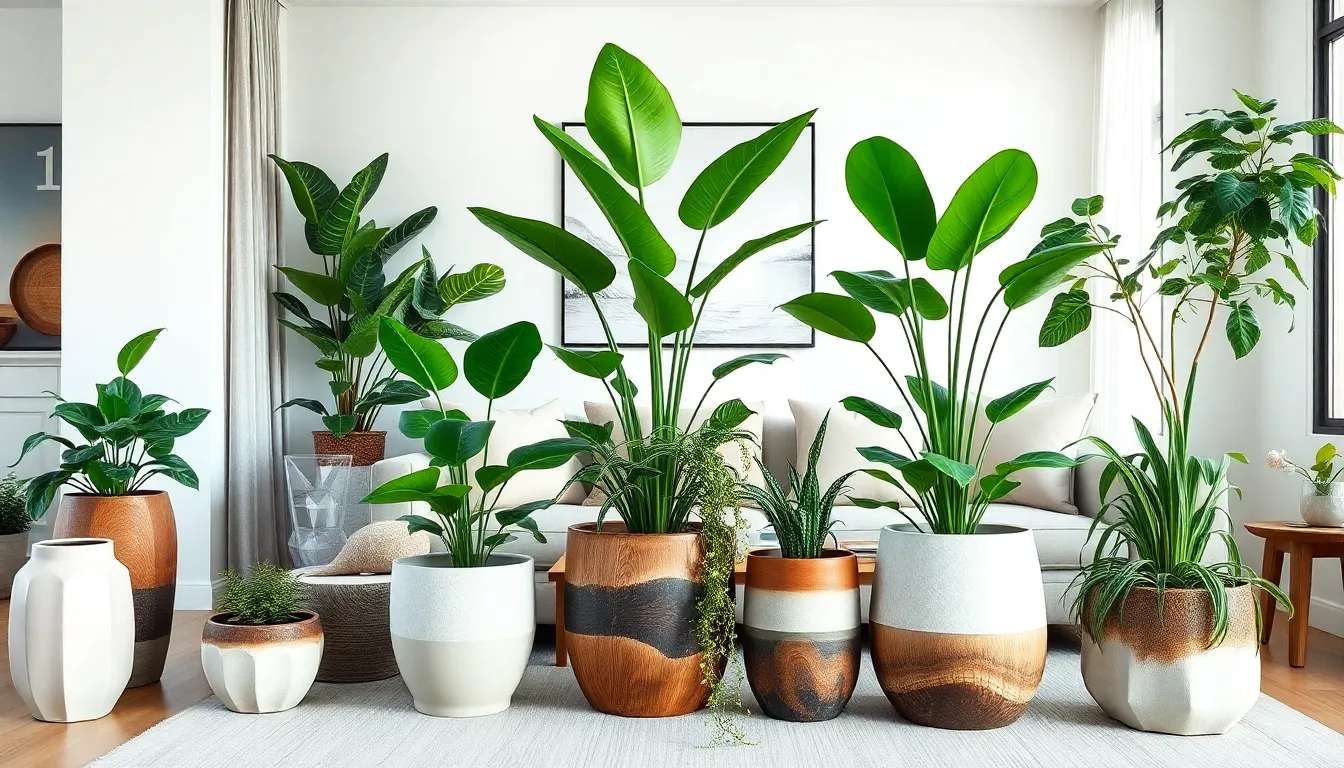
Selecting the right planters transforms your plant display from ordinary to extraordinary while maintaining the sophisticated aesthetic we’ve been building throughout your home.
Select Containers That Match Your Interior Style
Modern interiors thrive with sleek ceramic or concrete pots that echo clean lines and minimalist design principles. These contemporary containers provide the perfect backdrop for statement plants like fiddle leaf figs or rubber trees we discussed earlier.
Rustic and bohemian spaces call for woven baskets, terracotta, or wooden planters that enhance the organic warmth these design styles celebrate. Natural materials create seamless connections between your plant collections and existing furniture pieces.
Floor planters work best for larger statement plants like palms or monsteras that anchor your room’s botanical focal points. We recommend choosing substantial containers that can support the growth of these impressive specimens while maintaining visual proportion.
Smaller decorative pots serve tabletops and shelves where medium sized plants add layered interest to your carefully arranged heights. These containers should complement rather than compete with your plant groupings.
Hanging planters like macramé or ceramic cups maximize vertical space for trailing plants such as String of Pearls. These elevated containers create the forest canopy effect we’ve emphasized while keeping delicate plants safely positioned.
Coordinate Colors and Materials Across Rooms
Neutral planter colors like white, beige, or black provide maximum versatility when coordinating with existing wall colors, furniture, and textiles throughout your home. These foundational tones allow your plant’s natural beauty to remain the focal point.
Metallic or pastel pots add subtle color pops that can tie into accent pieces or artwork without overwhelming your carefully balanced aesthetic. Consider how these colors interact with the plant groupings we’ve established using the Rule of Odds.
Repeating ceramic materials across different rooms maintains visual flow between spaces while reinforcing your home’s cohesive plant aesthetic. This consistency helps unify separate areas into one harmonious environment.
Natural materials like wood or rattan enhance cozy, earthy vibes that complement the organic clustering techniques we’ve discussed. These textures create depth within your plant arrangements while softening architectural lines.
Mixing planter heights and textures creates visual depth by combining smooth ceramics with textured baskets across your thoughtfully distributed plant clusters. This variety prevents monotony while maintaining the sophisticated balance essential to your house with plants aesthetic.
Transform Your Kitchen Into a Plant Paradise
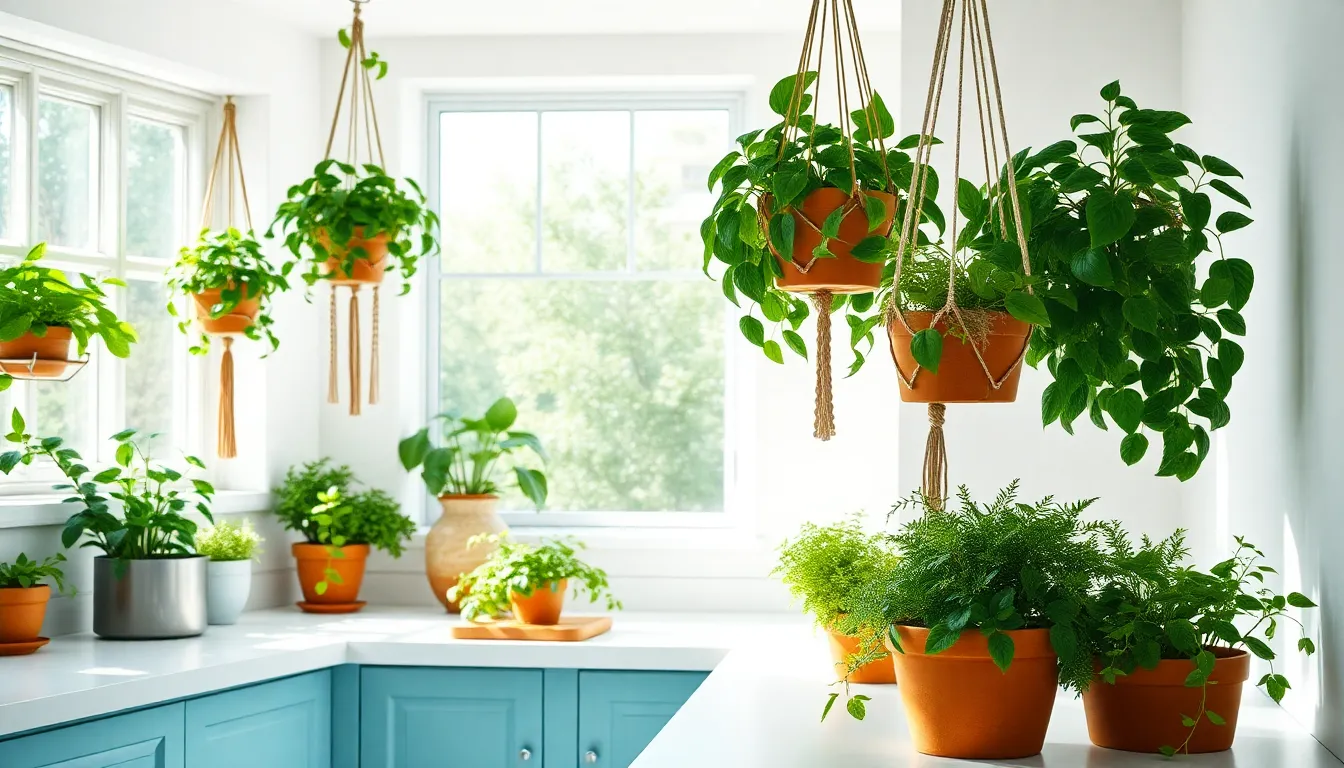
Kitchen spaces offer exceptional opportunities for showcasing the house with plants aesthetic while maintaining functionality. Houseplants such as snake plants, spider plants, and jade plants thrive in kitchen environments due to their hardiness and visual appeal.
Add Herb Gardens for Function and Beauty
Herb gardens combine utility and aesthetics in ways that perfectly complement our plant-filled kitchen vision. Basil, mint, rosemary, and thyme flourish in sunny kitchen windows or under grow lights, providing fresh ingredients while adding visual interest. We can create dedicated herb planters or install vertical wall gardens that offer easy access to cooking essentials while maintaining our botanical theme.
Stylish containers allow us to match herb gardens with existing kitchen decor, creating cohesive design elements throughout the space. Different herb varieties introduce varied shades of green that add depth to our plant collection. Fresh herbs also contribute pleasant aromas that enhance the sensory experience of our kitchen environment.
Strategic placement of herb gardens on windowsills, shelves, and open countertops maximizes natural light exposure while keeping frequently used ingredients within reach. We can arrange herbs of different heights to create visual layers that mirror the forest canopy effect discussed in previous sections.
Use Hanging Plants to Maximize Counter Space
Hanging plants such as pothos, ivy, and string of pearls solve the challenge of limited counter or floor space in busy kitchens. Macrame holders and hanging planters free up valuable work surfaces while drawing the eye upward to make rooms feel larger and more open. We position these trailing houseplants to soften sharp architectural lines and add movement to our kitchen design.
Vertical space utilization becomes essential when we want to maximize our plant collection without compromising functionality. Properly positioned hanging plants allow for better air circulation while creating depth throughout the room. String of pearls and trailing pothos varieties offer cascading greenery that adds organic flow to geometric kitchen layouts.
Strategic placement of hanging plants near windows ensures adequate light exposure while maintaining easy access for watering and maintenance. We can vary the heights of different hanging planters to create the layered effect that enhances our overall house with plants aesthetic. Multiple hanging plants distributed throughout the kitchen prevent overcrowding while maintaining visual balance across the entire space.
Create a Bedroom Oasis With Air-Purifying Plants
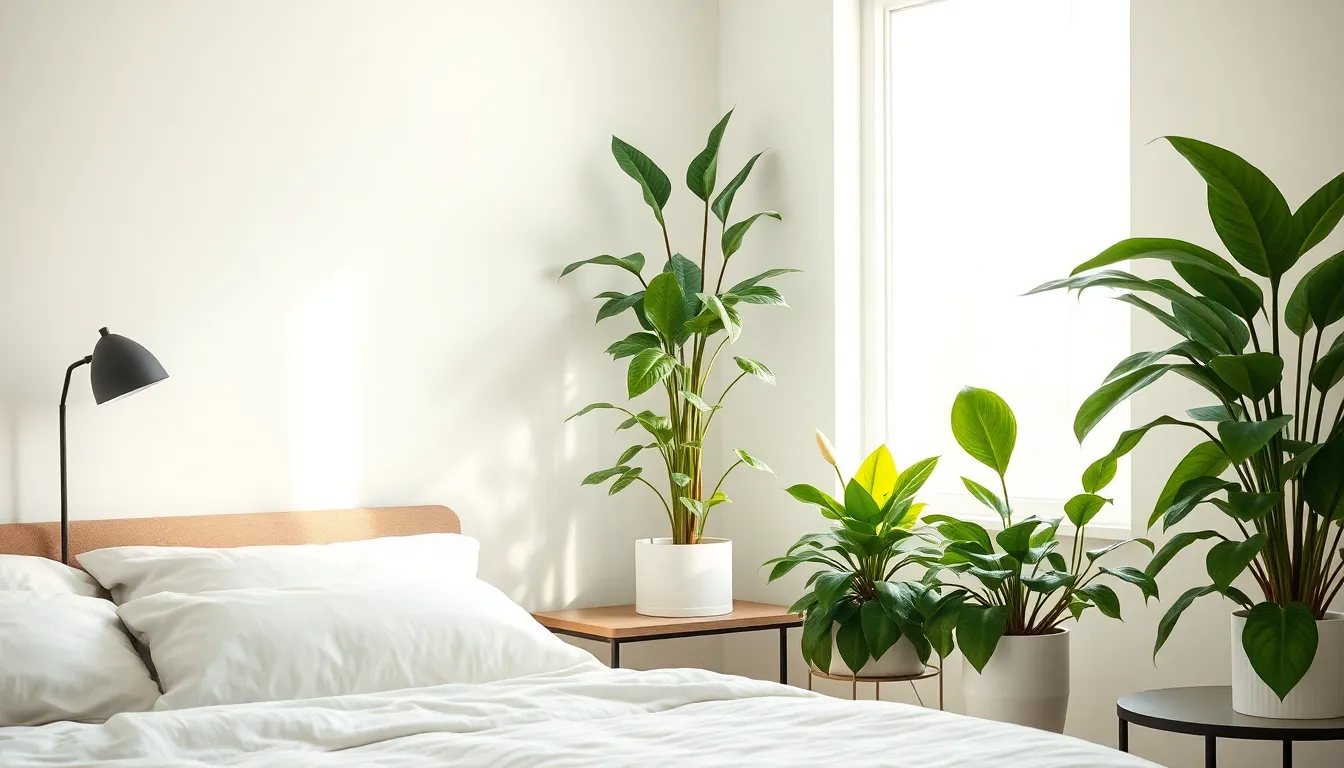
Transforming your bedroom into a tranquil sanctuary involves selecting plants that actively improve air quality while you sleep. Air-purifying plants such as Areca Palm, Snake Plant, and Peace Lily can remove toxins and increase oxygen levels, making your bedroom a healthier retreat that promotes restful sleep.
Select Low-Light Plants for Peaceful Sleep
Low-light tolerant plants thrive in bedroom environments where natural sunlight is often limited. Snake Plants and ZZ Plants continue photosynthesis at night, releasing oxygen and improving air quality without requiring direct sunlight exposure. These resilient varieties adapt perfectly to shaded bedroom conditions while maintaining their lush appearance.
Peaceful sleep becomes more achievable when we choose plants that function optimally in dim lighting. ZZ Plants demonstrate remarkable durability in low-light spaces, requiring minimal maintenance while contributing to cleaner indoor air. Snake Plants offer the unique benefit of nocturnal oxygen production, supporting better breathing throughout the night.
Night-friendly plants eliminate the need for bright grow lights that could disrupt your sleep cycle. Both Snake Plants and ZZ Plants tolerate neglect and irregular watering schedules, making them ideal for busy lifestyles. Their architectural forms add visual interest to bedrooms without overwhelming the peaceful atmosphere we’re cultivating.
Position Plants for Morning Light Exposure
Morning light positioning enhances plant vitality and supports natural circadian rhythms in your bedroom space. East-facing windows provide gentle, indirect sunlight that energizes plants like Ferns, Fiddle Leaf Fig, and Monstera Deliciosa without creating harsh shadows or excessive heat. Strategic placement near these windows maximizes the air-purifying benefits while creating an aesthetically pleasing display.
Gentle morning sunlight activates photosynthesis processes that improve your plants’ natural detoxification abilities. Monstera Deliciosa and Fiddle Leaf Fig respond particularly well to consistent morning exposure, developing fuller foliage and stronger stems. This positioning also allows you to wake up to vibrant greenery that sets a positive tone for each day.
Plant positioning for morning light creates a natural rhythm that aligns with your daily routine. Ferns appreciate the humid morning air and softer light conditions, thriving in east-facing bedroom locations. We can rotate plants weekly to ensure even light distribution and prevent them from leaning toward the window, maintaining their balanced growth patterns.
Design a Plant-Forward Bathroom Retreat
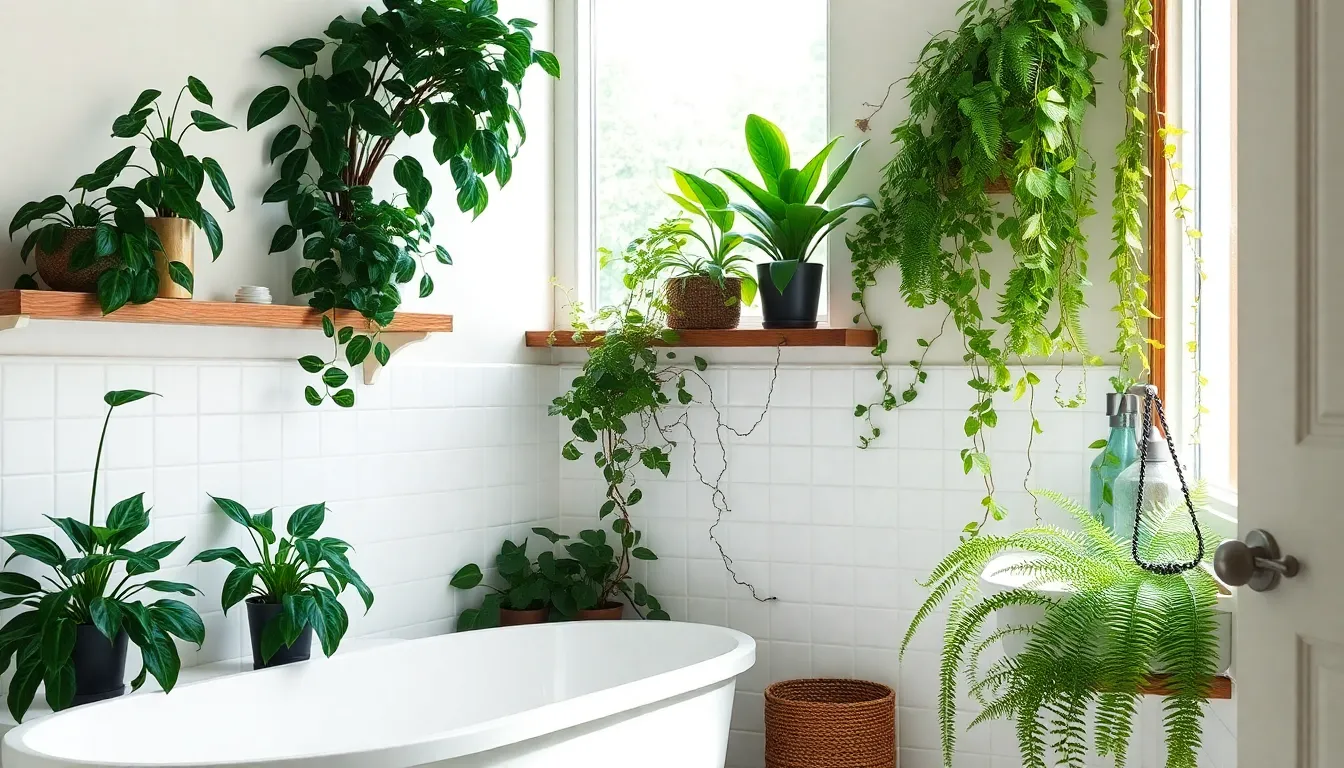
We can transform our bathroom into a lush sanctuary that seamlessly extends our house with plants aesthetic throughout the home. This intimate space offers unique opportunities to create a spa-like atmosphere where humidity-loving greenery thrives naturally.
Choose Humidity-Loving Plants for Shower Areas
Pothos stands out as our top choice for steamy bathroom environments, offering trailing vines that effortlessly soften harsh architectural lines around shower fixtures. We love how this easy-care plant adapts to various light conditions while thriving in the moist air generated by daily showers.
Heartleaf Philodendron brings lush, heart-shaped foliage that cascades gracefully from elevated positions near shower areas. We recommend placing these plants on shower caddies or nearby shelves where they can benefit from the humid microclimate.
Ferns like Boston ferns add soft, textured layers to our bathroom plant collection while absolutely loving the moisture-rich environment. We find they create stunning focal points when positioned on corner shelves or hanging baskets near shower spaces.
Calatheas and Prayer Plants offer vibrant leaf patterns that become conversation pieces in our bathroom retreats. We appreciate how these humidity-tolerant plants maintain their colorful markings while purifying the steamy air around shower areas.
Use Trailing Plants on Shelves and Windowsills
Cascading arrangements create movement and visual depth in our bathroom spaces where rigid fixtures typically dominate the design. We position trailing varieties like Pothos and Heartleaf Philodendron on high shelves to achieve this natural waterfall effect.
Windowsill positioning maximizes natural light exposure while allowing trailing plants to frame our bathroom windows beautifully. We select plants that can handle the fluctuating humidity levels near windows while adding organic curves to otherwise angular spaces.
Shelf styling becomes an art form when we layer trailing plants at different heights throughout our bathroom retreat. We combine various pot sizes and plant lengths to fill awkward corners and transform empty vertical spaces into green sanctuaries.
Architectural softening occurs naturally when we strategically place trailing plants to counterbalance the hard edges of bathroom fixtures and tile work. We find this approach creates a serene plant oasis that feels both luxurious and refreshingly natural.
Maximize Natural Light for Your House With Plants Aesthetic
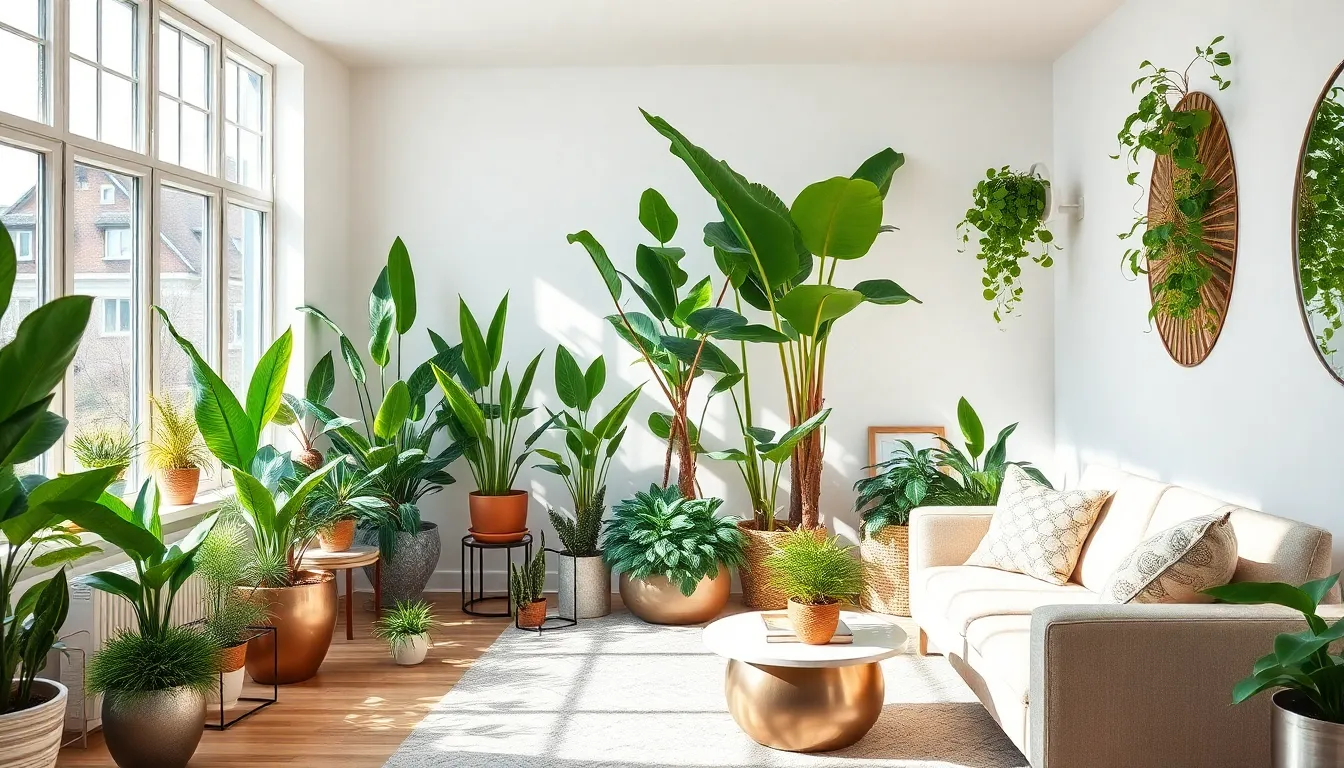
Natural light serves as the foundation for a thriving house with plants aesthetic, ensuring your green companions flourish while creating stunning visual displays. We’ll explore strategic approaches to harness and amplify available sunlight throughout your plant filled spaces.
Position Plants Near Windows for Optimal Growth
Place your plants close to windows where they can receive ample natural sunlight, which is essential for photosynthesis and vibrant growth. South or east facing windows typically provide the best light for most indoor plants like fiddle leaf figs, monstera deliciosas, and rubber trees. We recommend avoiding obstructions that block sunlight from reaching your plants to ensure they get maximum exposure.
Consider the exact light requirements of each plant species when positioning them near windows. Calathea and other tropical plants thrive in bright, indirect light from east facing windows, while sun loving herbs like basil and rosemary prefer the intense southern exposure. Position delicate ferns and peace lilies slightly back from windows to prevent leaf scorch while still providing adequate illumination.
Create layered arrangements around windows to accommodate plants with varying light needs. Place light hungry statement plants directly in window areas, with medium light plants positioned just behind them. This strategic layering maximizes your window real estate while ensuring each plant receives appropriate light levels for optimal health and aesthetic appeal.
Use Mirrors to Reflect Light Throughout Plant Displays
Mirrors and other reflective surfaces can amplify natural light by bouncing it deeper into your room, illuminating plants that are farther from windows. Positioning mirrors opposite or adjacent to windows can increase light availability, creating a brighter environment that benefits your plants and enhances the overall aesthetic.
Strategic mirror placement doubles the visual impact of your plant arrangements while solving lighting challenges in darker corners. We suggest installing large mirrors behind plant groupings to create depth and reflect both natural light and the lush greenery itself. This technique works particularly well with trailing plants like pothos and string of pearls, as the mirror captures their cascading movement.
Incorporate metallic planters and reflective surfaces throughout your plant displays to maximize light distribution. Brass, copper, and polished ceramic containers bounce light upward to benefit overhead plants while adding sophisticated design elements. These reflective materials work especially well in modern interiors where clean lines and natural textures create harmonious plant filled environments.
Incorporate Vertical Gardens and Living Walls
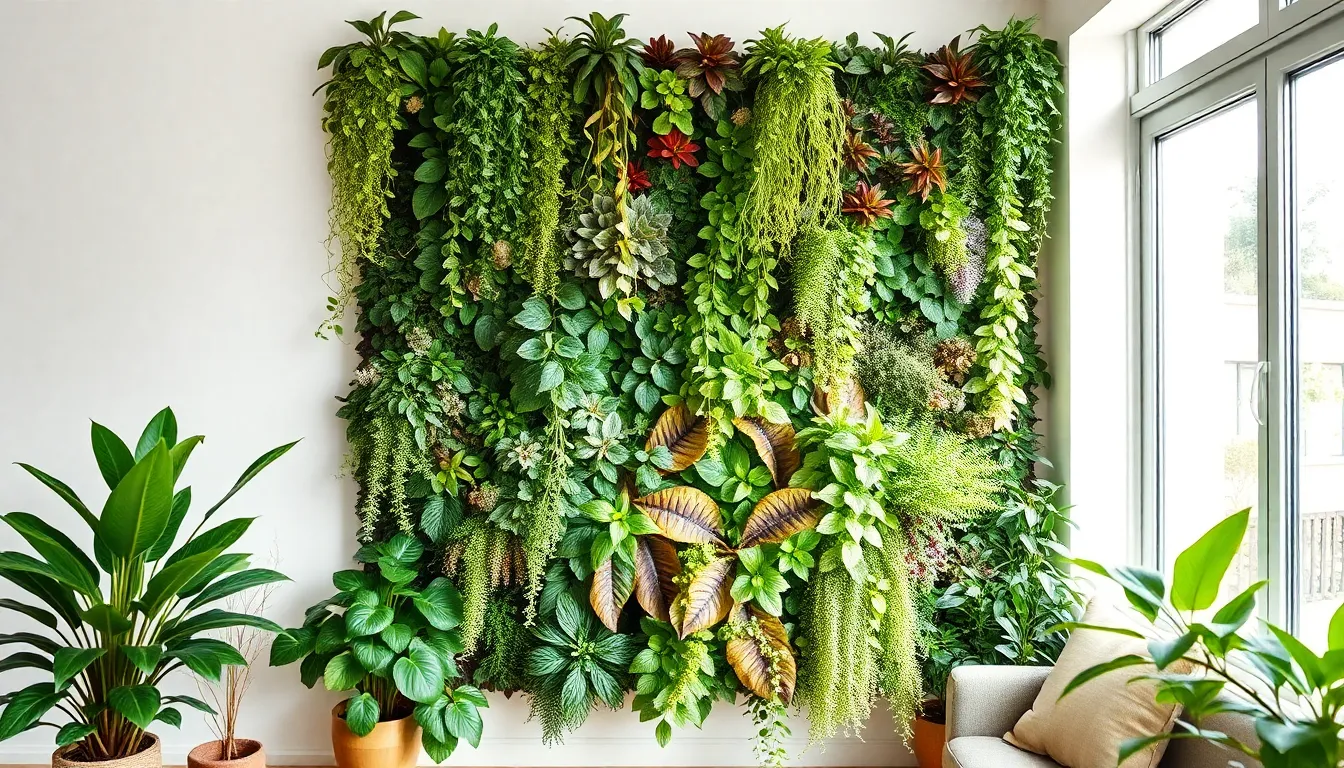
Vertical gardening transforms empty wall spaces into stunning living artworks that maximize our home’s plant aesthetic potential. These installations bring abundant greenery indoors without consuming valuable floor space, creating dramatic focal points that add texture and life to any room.
Install Wall-Mounted Planters for Small Spaces
Wall-mounted planters offer the perfect solution for maximizing our plant displays in compact living areas. We can arrange these versatile containers in grids, staggered patterns, or hanging configurations to create visually captivating layers of greenery at different heights.
String of Pearls creates beautiful cascading effects when positioned in wall-mounted planters above eye level. Herbs like basil, rosemary, and thyme thrive in these setups while providing fresh ingredients for our kitchen adventures. Compact shrubs and trailing vines adapt exceptionally well to vertical mounting systems, allowing us to cultivate lush plant corners or accent walls without sacrificing precious square footage.
Small apartments benefit tremendously from this space-saving approach, as wall-mounted planters transform underutilized vertical surfaces into productive growing areas. We can create cozy plant nooks by clustering several wall-mounted containers at varying heights, establishing visual depth while maintaining easy access for plant care and maintenance.
Create Dramatic Focal Points With Plant Walls
Plant walls serve as breathtaking centerpieces that anchor our living areas, entryways, and kitchens with natural sophistication. We achieve the most striking results by carefully selecting plants with contrasting textures, colors, and shapes to design personalized living art pieces that reflect our unique style preferences.
Large-leafed species like Fiddle Leaf Fig create bold architectural statements when combined with delicate ferns and flowering plants in modular arrangements. Tropical palms add exotic elegance to our plant walls, while Monstera and Birds of Paradise contribute dramatic vertical interest that enhances our home’s overall aesthetic appeal.
Shelving systems and modular planter arrangements provide flexibility in plant placement and simplify ongoing maintenance routines. We can easily rearrange our plant wall compositions as our collection grows, ensuring our living walls remain fresh and visually compelling throughout the seasons.
These vertical installations improve air quality while promoting calming natural atmospheres that transform our interiors into serene, nature-inspired environments. Plant walls enhance existing architectural features through living green design, creating sophisticated focal points that seamlessly blend modern aesthetics with organic beauty.
Maintain Your Plant Aesthetic With Proper Care Routines
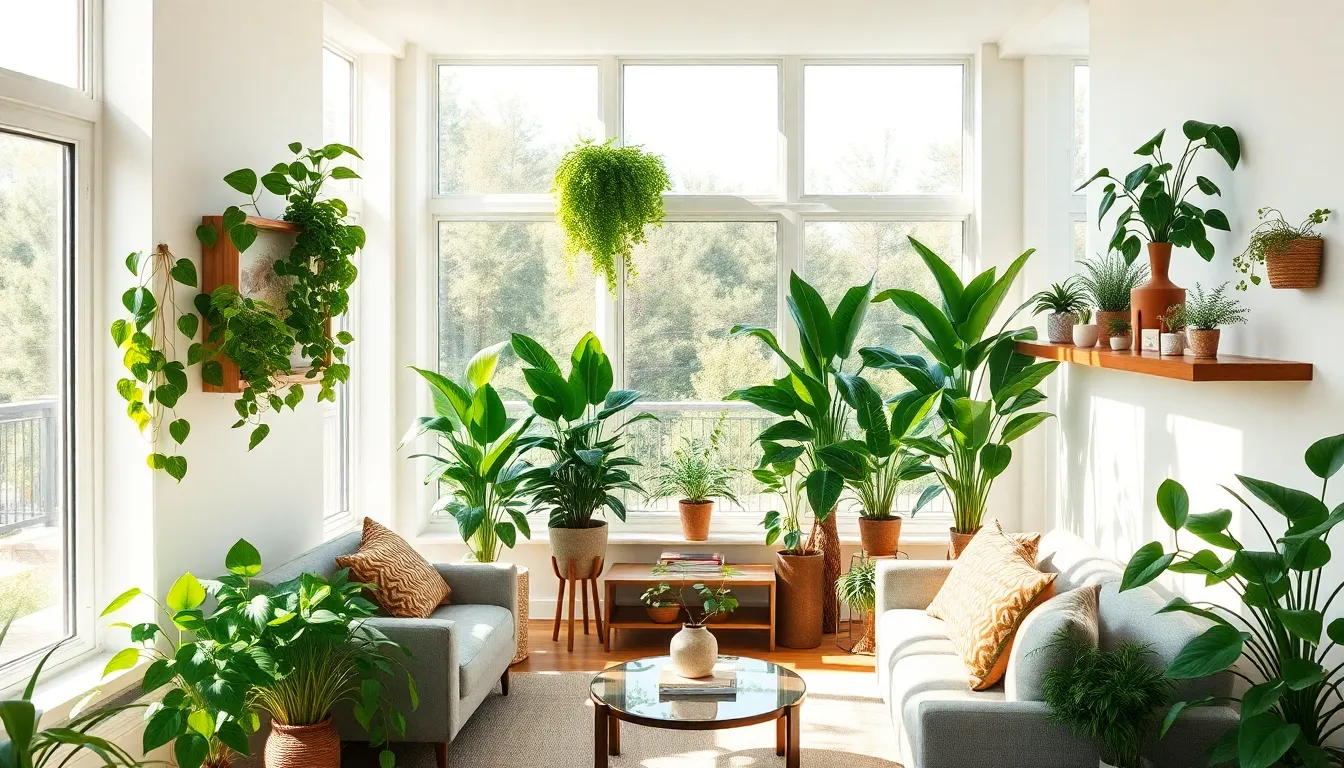
Creating a stunning house with plants aesthetic requires more than just arranging beautiful foliage throughout your home. We need consistent care routines that keep our plants vibrant and healthy to preserve the visual appeal we’ve worked so hard to achieve.
Establish Watering and Fertilizing Schedules
Watering schedules customized to each plant’s exact needs form the foundation of maintaining our house with plants aesthetic. Overwatering can lead to root rot and yellowing leaves that detract from our carefully curated displays, while underwatering causes wilting and browning that ruins the lush appearance we desire. We recommend checking soil moisture levels weekly for most houseplants, adjusting frequency based on seasonal changes and individual plant requirements.
Fertilizing on a regular schedule supports the healthy growth and lush foliage that contributes directly to our aesthetic appeal. During growing seasons (spring and summer), we should feed our plants every 2-4 weeks with a balanced liquid fertilizer to maintain vibrant colors and robust growth. Popular aesthetic plants like Pothos, Heartleaf Philodendron, and Jade plants respond particularly well to consistent feeding schedules that keep their foliage dense and colorful.
Consistency in our care routines prevents the stress that can compromise both plant health and visual impact. We find that creating a weekly plant care calendar helps us track watering dates, fertilizer applications, and seasonal adjustments for each species in our collection. This systematic approach ensures that our plants continue to enhance our interior design rather than becoming eyesores due to neglect.
Monitor Plant Health and Replace When Necessary
Monitoring plant health attentively allows us to catch problems before they affect our house with plants aesthetic. We should examine our plants weekly for signs of pests like spider mites or aphids, diseases such as powdery mildew, and stress indicators including leaf drop or color changes. Healthy plants maintain their intended color and form, which remains crucial for preserving the overall aesthetic impact of our spaces.
Removing or replacing declining plants immediately prevents them from detracting from our carefully planned botanical displays. When plants show persistent signs of poor health even though proper care, we need to make the difficult decision to replace them to maintain the fresh, lively environment we’ve created. This proactive approach keeps our plant aesthetic looking intentional and well maintained rather than neglected.
Strategic plant placement maximizes both visual impact and health outcomes for our house with plants aesthetic. We should position trailing plants like Heartleaf Philodendron on shelves or in hanging baskets where they can cascade naturally, while placing statement plants like Cornstalk Dracaena in spots that highlight their architectural qualities. Using planters that match our room’s color palette enhances the overall style without detracting from the natural beauty of our plants.
Conclusion
Creating a house with plants aesthetic transforms our living spaces into vibrant sanctuaries that nurture both our well-being and our design sensibilities. We’ve discovered that success lies in thoughtful plant selection strategic placement and consistent care routines that keep our green companions thriving.
The beauty of this aesthetic approach is its adaptability to any home size or style. Whether we’re working with expansive rooms or compact apartments vertical gardens and carefully chosen containers help us maximize our plant displays without overwhelming our spaces.
By embracing the principles we’ve explored—from statement plants to strategic groupings and room-exact selections—we can cultivate homes that breathe with natural life. Our plant-filled spaces become more than just stylish; they become personal retreats that reflect our connection to nature and enhance our daily living experience.
Frequently Asked Questions
What is the “house with plants” aesthetic?
The house with plants aesthetic is a design trend that incorporates greenery throughout living spaces to create a harmonious balance between natural elements and modern decor. This style transforms homes into serene, chic retreats while promoting wellness and enhancing visual appeal without overwhelming the space.
Which plants work best as statement pieces in home decor?
Large statement plants like fiddle leaf figs, monstera deliciosas, bird of paradise plants, and rubber trees work exceptionally well. These plants create bold focal points with their dramatic vertical interest, tropical sophistication, exotic elegance, and glossy textures that complement modern decor styles.
How should I arrange plants to create visual depth in my home?
Create visual depth by varying plant heights to mimic natural forest canopies. Position trailing plants on high shelves, place bushier plants on lower surfaces, and group plants in odd numbers (three or five) using the “Rule of Odds” for more dynamic and appealing displays.
What types of planters complement the house with plants aesthetic?
Choose planters that match your decor style: sleek ceramic or concrete pots for modern interiors, woven baskets or terracotta for rustic spaces. Use substantial floor planters for statement plants, smaller decorative pots for tabletops, and hanging planters for trailing varieties to maximize vertical space.
Which plants are best for kitchens?
Hardy houseplants like snake plants, spider plants, and jade plants thrive in kitchen environments. Consider incorporating herb gardens with basil, mint, rosemary, and thyme for sunny windows. Hanging plants like pothos and ivy maximize counter space while maintaining functionality.
What plants work well in bedrooms?
Air-purifying plants like Areca Palm, Snake Plant, and Peace Lily are ideal for bedrooms. These low-light tolerant plants improve air quality, promote restful sleep, and thrive in dim conditions while contributing to a tranquil sanctuary atmosphere.
How can I incorporate plants in bathrooms?
Humidity-loving plants like Pothos, Heartleaf Philodendron, and Boston ferns excel in bathroom environments. Position trailing plants on shelves and windowsills to create movement, visual depth, and soften hard edges of bathroom fixtures for a luxurious spa-like atmosphere.
How do I maximize natural light for my plants?
Position plants strategically near windows based on their specific light requirements. Use mirrors and reflective surfaces to amplify natural light throughout your displays. East-facing windows are particularly beneficial for morning light exposure that energizes plants and enhances air-purifying abilities.
What are vertical gardens and how do they work?
Vertical gardens utilize wall space to create living artworks without taking up floor space. Use wall-mounted planters at varying heights, incorporate cascading plants like String of Pearls, and combine contrasting textures. This approach is perfect for small apartments and underutilized vertical surfaces.
How do I maintain the plant aesthetic long-term?
Establish consistent watering and fertilizing schedules tailored to each plant’s needs. Monitor plant health regularly to catch issues early, replace declining plants promptly, and ensure strategic placement for optimal growth conditions. Regular maintenance preserves the beauty and vitality of your arrangements.

